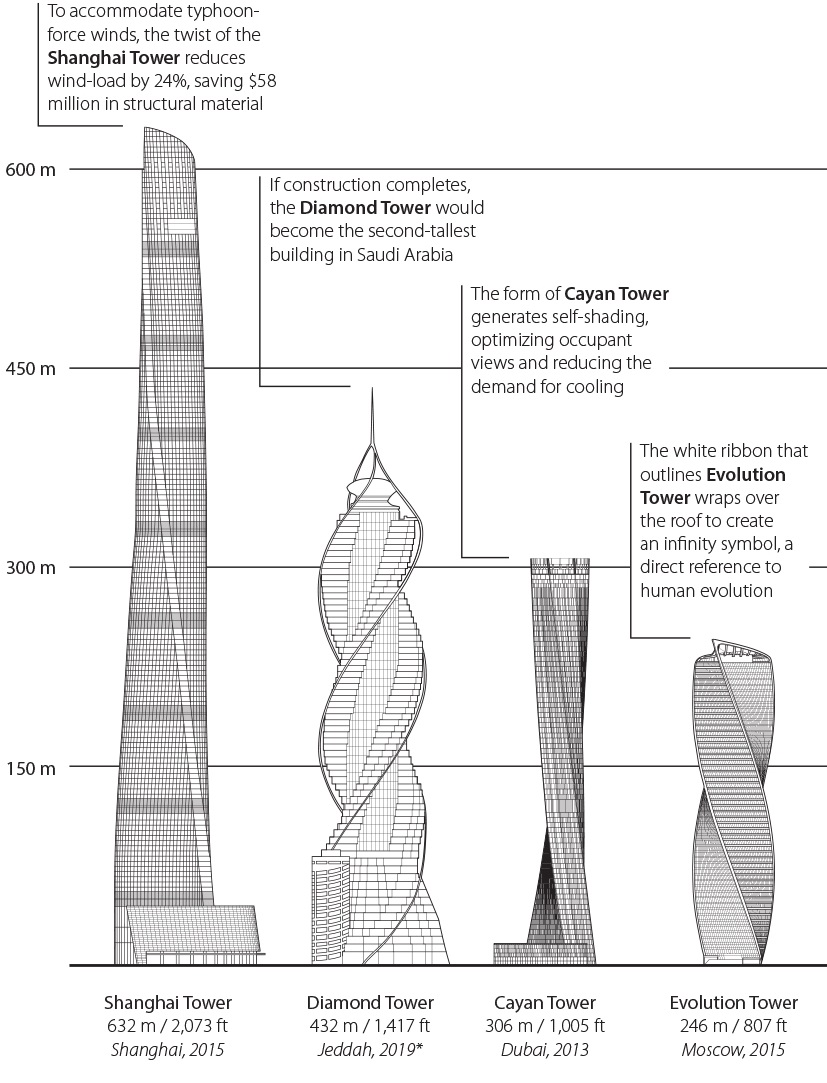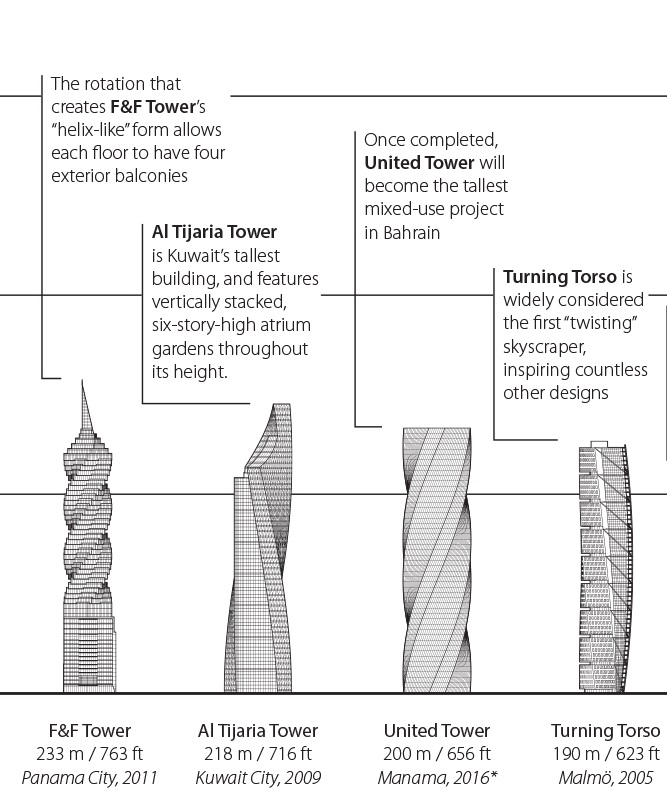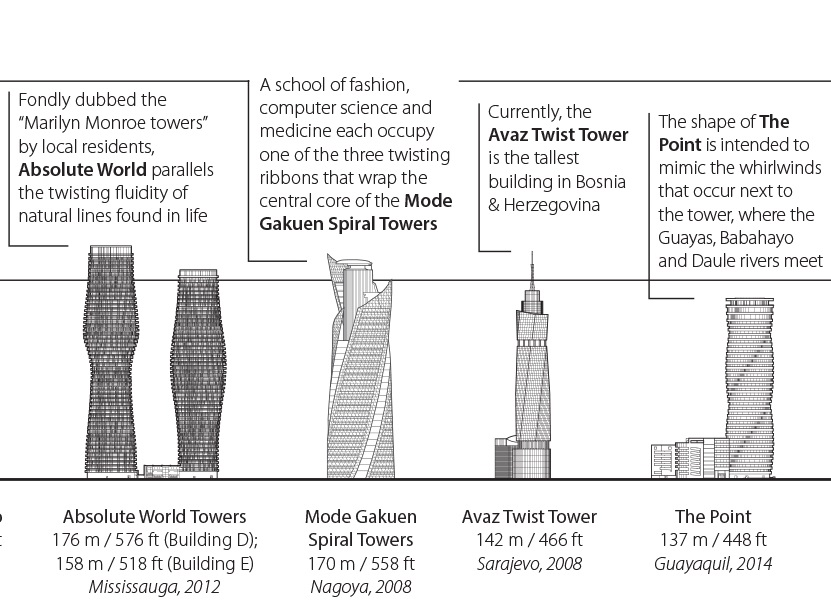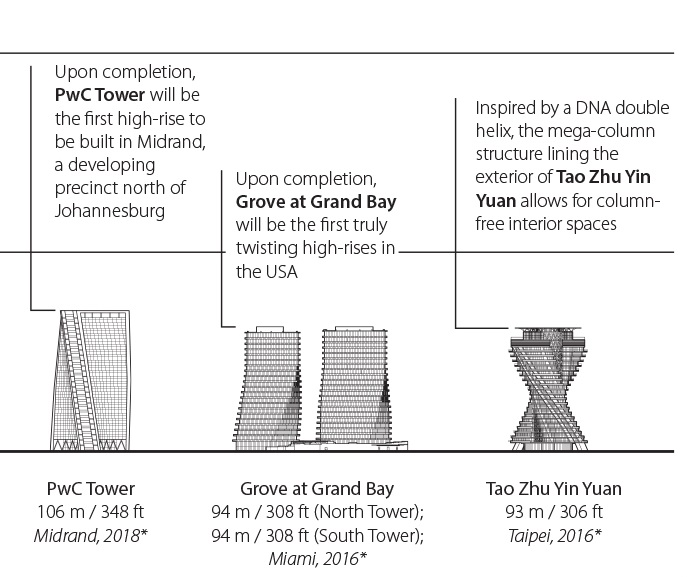Twisting buildings
In August 2016, the Council on Tall Buildings and Urban Habitat (CTBUH) published a new study, Twisting Tall Buildings, examining the recent proliferation of spiralling towers being developed around the world.
The report defines a building as ‘twisting’ if it progressively rotates its floor plates or its façade as it gains height. It is usual that each plate will be similarly shaped in plan, and turned on a shared axis a consistent number of degrees from the preceding floor.
Not only are these ‘twisters’ often aerodynamic and energy-efficient as a result of their design, they are able to incorporate a wide variety of textures, view angles and ripple effects.
The report identifies 28 twisting towers that are either complete or under construction. This is evidence, the report says, of a growing trend in this new type of structure.
 At 632 m (2,073 ft) tall, the Shanghai Tower is currently (2016) the second tallest building in the world.
At 632 m (2,073 ft) tall, the Shanghai Tower is currently (2016) the second tallest building in the world.
The Diamond Tower in Jeddah, scheduled for completion in 2019, will be the world’s second tallest twisting tower, and the only building to twist a full 360-degrees along its height.
F&F Tower, Panama City, holds the record for the ‘tightest’ twist, that is, the greatest average rotation per floor, at 5.943-degrees across each of its 53 floors.
CTBUH is the world’s leading resource for professionals focused on the inception, design, construction, and operation of tall buildings and future cities.
Images and content courtesy of CTBUH.
[edit] Related articles on Designing Buildings Wiki
Featured articles and news
RTPI leader to become new CIOB Chief Executive Officer
Dr Victoria Hills MRTPI, FICE to take over after Caroline Gumble’s departure.
Social and affordable housing, a long term plan for delivery
The “Delivering a Decade of Renewal for Social and Affordable Housing” strategy sets out future path.
A change to adoptive architecture
Effects of global weather warming on architectural detailing, material choice and human interaction.
The proposed publicly owned and backed subsidiary of Homes England, to facilitate new homes.
How big is the problem and what can we do to mitigate the effects?
Overheating guidance and tools for building designers
A number of cool guides to help with the heat.
The UK's Modern Industrial Strategy: A 10 year plan
Previous consultation criticism, current key elements and general support with some persisting reservations.
Building Safety Regulator reforms
New roles, new staff and a new fast track service pave the way for a single construction regulator.
Architectural Technologist CPDs and Communications
CIAT CPD… and how you can do it!
Cooling centres and cool spaces
Managing extreme heat in cities by directing the public to places for heat stress relief and water sources.
Winter gardens: A brief history and warm variations
Extending the season with glass in different forms and terms.
Restoring Great Yarmouth's Winter Gardens
Transforming one of the least sustainable constructions imaginable.
Construction Skills Mission Board launch sector drive
Newly formed government and industry collaboration set strategy for recruiting an additional 100,000 construction workers a year.
New Architects Code comes into effect in September 2025
ARB Architects Code of Conduct and Practice available with ongoing consultation regarding guidance.
Welsh Skills Body (Medr) launches ambitious plan
The new skills body brings together funding and regulation of tertiary education and research for the devolved nation.
Paul Gandy FCIOB announced as next CIOB President
Former Tilbury Douglas CEO takes helm.
UK Infrastructure: A 10 Year Strategy. In brief with reactions
With the National Infrastructure and Service Transformation Authority (NISTA).

























